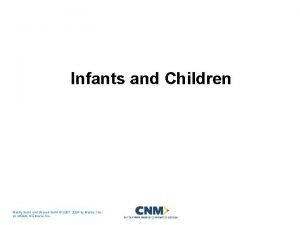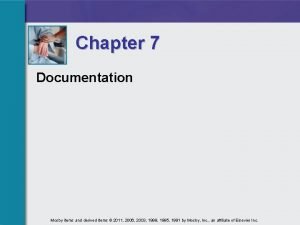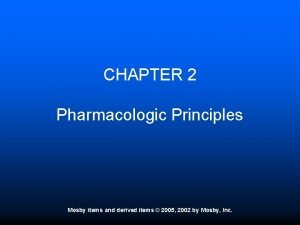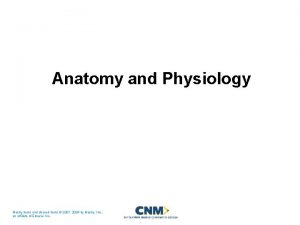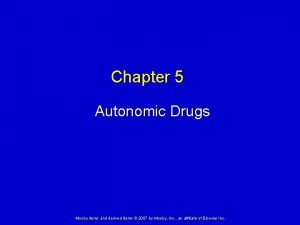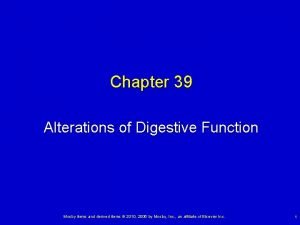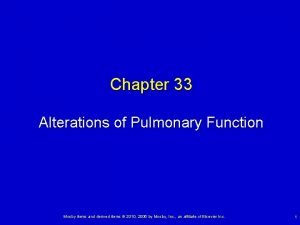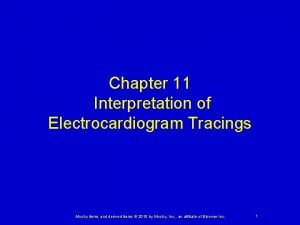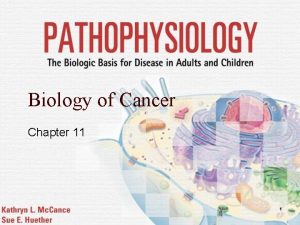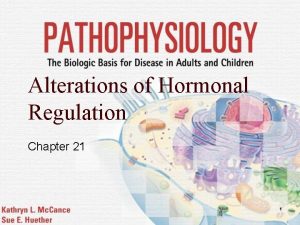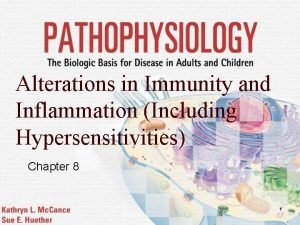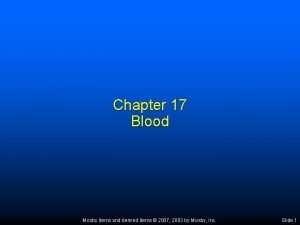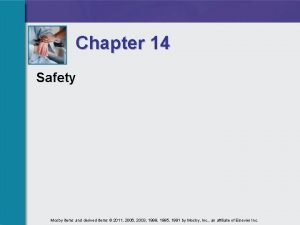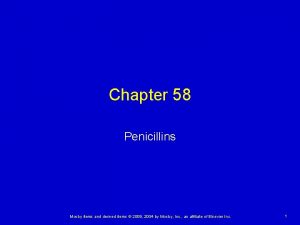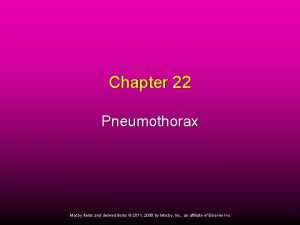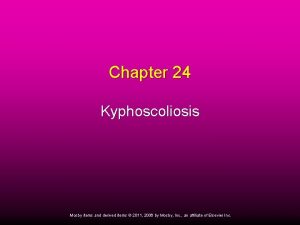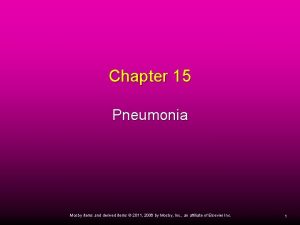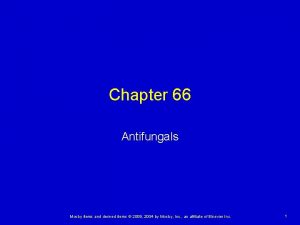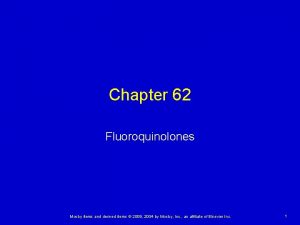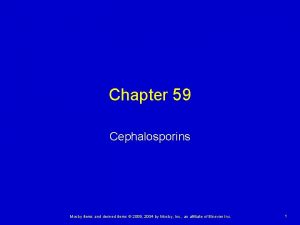Chapter 8 Xanthines Mosby items and derived items

Chapter 8 Xanthines Mosby items and derived items © 2008, 2002 by Mosby, Inc. , an affiliate of Elsevier Inc.

Clinical Indications for Use of Xanthines Use in asthma Theophylline: maintenance therapy (step 2 or higher) of mild, persistent asthma Ø Side effects and narrow therapeutic index may make it a poor choice versus other agents Ø Mosby items and derived items © 2008, 2002 by Mosby, Inc. , an affiliate of Elsevier Inc.

Clinical Indications for Use of Xanthines (cont’d) Use in COPD Ø Theophylline: recommended by GOLD as alternative to β 2 agonist and anticholinergics Use in apnea of prematurity First-line treatment Ø Theophylline most often used, but caffeine citrate may be better choice (safer, higher therapeutic index) Ø Mosby items and derived items © 2008, 2002 by Mosby, Inc. , an affiliate of Elsevier Inc.

Specific Xanthine Agents a. k. a. methylxanthines Found as alkaloids in plant species Theophylline Ø Theobromine Ø Tea leaves Cocoa seeds or beans Caffeine Coffee beans and kola nuts Ø Cocoa seeds or beans Ø Tea leaves Ø Mosby items and derived items © 2008, 2002 by Mosby, Inc. , an affiliate of Elsevier Inc.

General Pharmacological Properties Effects on humans Ø Ø CNS stimulation Cardiac muscle stimulation Diuresis Bronchial, uterine, and vascular smooth muscle relaxation • Theophylline is generally classified as a bronchodilator Peripheral and coronary vasodilation Ø Cerebral vasoconstriction Ø • Used in headache remedies Mosby items and derived items © 2008, 2002 by Mosby, Inc. , an affiliate of Elsevier Inc.

General Pharmacological Properties (cont’d) Structure-activity relations Ø Theophylline • Methyl attachments at N-1 and N-3 enhance bronchodilation/increase side effects Ø Caffeine Ø Dyphylline • Additional methyl group at N-7 decreases bronchodilation • Derivative of theophylline with methyl attachment at N-7 that weakens bronchodilation Ø Enprofylline • Not available in United States • Potent bronchodilator • Large substitution at N-3 position Mosby items and derived items © 2008, 2002 by Mosby, Inc. , an affiliate of Elsevier Inc.

General Pharmacological Properties (cont’d) Proposed theories of activity Ø Exact mechanism of action unknown • Smooth muscle relaxation via inhibition of phosphodiesterase (? ) • Antagonism of adenosine (? ) • Catecholamine release (? ) Mosby items and derived items © 2008, 2002 by Mosby, Inc. , an affiliate of Elsevier Inc.

Titrating Theophylline Doses Individuals metabolize theophylline at different rates Equivalent doses of theophylline salts Anhydrous theophylline = 100% theophylline Ø Salts of theophylline not pure by weight Ø Mosby items and derived items © 2008, 2002 by Mosby, Inc. , an affiliate of Elsevier Inc.

Titrating Theophylline Doses (cont’d) Serum levels of theophylline Ø Ø Ø Asthma Ø <5 μg/ml: No effects seen 10 to 20 μg/ml: Therapeutic range >20 μg/ml: Nausea >30 μg/ml: Cardiac arrhythmias 40 to 45 μg/ml: Seizures 5 to 15 μg/ml COPD Ø 10 to 12 μg/ml Mosby items and derived items © 2008, 2002 by Mosby, Inc. , an affiliate of Elsevier Inc.

Titrating Theophylline Doses (cont’d) Dosage schedules Used to titrate drug levels Ø Rapid theophyllization: • 5 mg/kg lean body weight oral loading dose of Ø anhydrous theophylline • Each 0. 5 mg/kg = 1 μg/ml serum level Ø Slow titration: • 16 mg/kg/24 hr or 400 mg/24 hr (whichever is less) Mosby items and derived items © 2008, 2002 by Mosby, Inc. , an affiliate of Elsevier Inc.

Titrating Theophylline Doses (cont’d) Methods of titration: Clinical reaction of patient Serum drug levels 1 to 2 hours after administration (immediate release) Ø 5 to 9 hours after administration (sustained release) Ø Mosby items and derived items © 2008, 2002 by Mosby, Inc. , an affiliate of Elsevier Inc.

Theophylline Toxicity and Side Effects Narrow therapeutic margin Distressing side effects may occur at therapeutic levels Common side effects: Ø Gastric upset • Not recommended in patients with peptic ulcer or acute gastritis Headache Ø Anxiety Ø Diuresis Ø Mosby items and derived items © 2008, 2002 by Mosby, Inc. , an affiliate of Elsevier Inc.

Factors Affecting Theophylline Activity Conditions affecting liver/kidneys Interactions with other drugs Conditions that increase theophylline levels: Viral hepatitis Ø Left ventricular failure Ø Condition that decreases theophylline levels: Ø Smoking Additive effect: Ø β Agonists Mosby items and derived items © 2008, 2002 by Mosby, Inc. , an affiliate of Elsevier Inc.

Clinical Uses Asthma Use debated Ø Only after other relievers and controllers have failed Ø COPD Ø If ipratropium bromide and β 2 agonist fail to provide control Mosby items and derived items © 2008, 2002 by Mosby, Inc. , an affiliate of Elsevier Inc.

Nonbronchodilating Effects of Theophylline Increase in force of respiratory muscle contractility Increase in respiratory muscle endurance Increase in ventilatory drive Cardiovascular effects Increased cardiac output Ø Decreased pulmonary vascular resistance Ø Antiinflammatory effects Mosby items and derived items © 2008, 2002 by Mosby, Inc. , an affiliate of Elsevier Inc.

Use in Apnea of Prematurity Xanthines are the first-line choice when nonpharmacological methods unsuccessful Caffeine citrate preferred over theophylline Loading dose of 20 mg/kg Ø Daily maintenance dose of 5 mg/kg Ø Mosby items and derived items © 2008, 2002 by Mosby, Inc. , an affiliate of Elsevier Inc.
- Slides: 16

